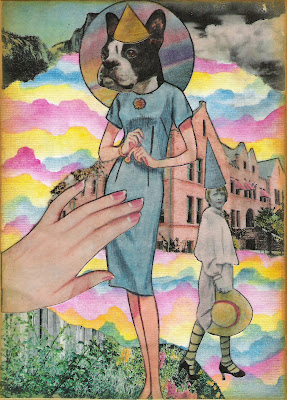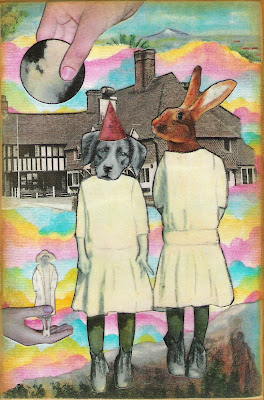Viewing: Blog Posts Tagged with: OOAK, Most Recent at Top [Help]
Results 1 - 3 of 3
Blog: doodles and noodles (Login to Add to MyJacketFlap)
JacketFlap tags: book art, business of art, OOAK, 3-D illustration, CPSIA, Add a tag
Blog: Garden Painter Art (Login to Add to MyJacketFlap)
JacketFlap tags: collage mixed media, OOAK, Etsy, rabbit, Kimberly Wlassak, Anthropomorphic Animals, gardenpainter4, dog, collage, Kimberly Wlassak, Etsy, gardenpainter4, rabbit, collage mixed media, Anthropomorphic Animals, OOAK, Add a tag
Good Morning:
Well, it's been over a week since I've made my way to my blog. Filling the big, white, and blank page seems such a heavy task, yet when I do have the words, I enjoy it so. Although I haven't many words lately, I have managed to finish two new collages. They are both listed in My Etsy Shop.
The first collage is a second piece in my "Fiona" series. It's a 5" x 7" on canvas:
FASHIONABLE FIONA
The second collage is another in my "Rabbit" series. It's a 4" x 6" on canvas and I like to classify it as "story art", as there is a story to the piece. It goes like this:
"What you get with this collage is a lovely summer afternoon somewhere in the English countryside. The kind of warm day with miniature breezes that call you to laze about. But on this day, Rabbit had an unexpected visit from her dear friend, Dog. Dog felt that the day was so warm and fresh that a party was in order. Dog brought hats and tea and scones. A nice time was had by all...BUT, something was amiss. There was a static in the air and a low howl far in the distance....
Now, you get to fill in the blank. The end of the story belongs to you!!"
RABBIT'S UNEXPECTED PARTY
Both of these pieces will, eventually, be offered in print form in my Etsy shop. If you are interested in either of these collages or a print of either one, but you don't have an Etsy account, feel free to email me for details. You can do so by going to the top left hand corner of my blog and click on the email button.
********************************************
As much as I loathe using my blog as a simple marketing tool, that must be what I use it for today, as I'm off to another busy day. Meds for my mom and picking up some medical records for her as well.
As always, thank you ever so much for stopping by and having a look at my new work. I truly appreciate it.
Until Next Time
Kim
Garden Painter Art
Blog: ThePublishingSpot (Login to Add to MyJacketFlap)
JacketFlap tags: Community, cartoon, comic strips, comic books, Funky Winkerbean, Add a tag
 What happens when you want to tell a story that no one has ever told before in your medium?
What happens when you want to tell a story that no one has ever told before in your medium?
This fall, comic strip writer Tom Batiuk will kill one of his characters in his comic strip, Funky Winkerbean. That's right, a character in the work-safe, family-safe, and some might say sanitized, world of daily comic strips, is going to die.
The Cleveland Free Times has a fascinating profile of this comic strip storyteller, who has already broken daily cartoon taboos by talking about breast cancer, high school pregnancy, and the Iraq War. His story will give any freelancer hope that someday they can support themselves by writing what they want to write.
As long as you're reading the funny pages, check out our exclusive interview with Woody Wilson, another comic strip writer who writes some of the most famous soap opera-style funnies. After that, spend some time exploring the Daily Cartoonist blog, a tremendous resource for writers of all stripes.
Read this Marshall Ramsey live-blogged cartoon process post for some inspiration. Finally, read The Comics Curmudgeon. The site is often misaligned as a comic-strip-hating, but really, it's the largest funnies-loving community site I've ever seen.
Add a Comment


